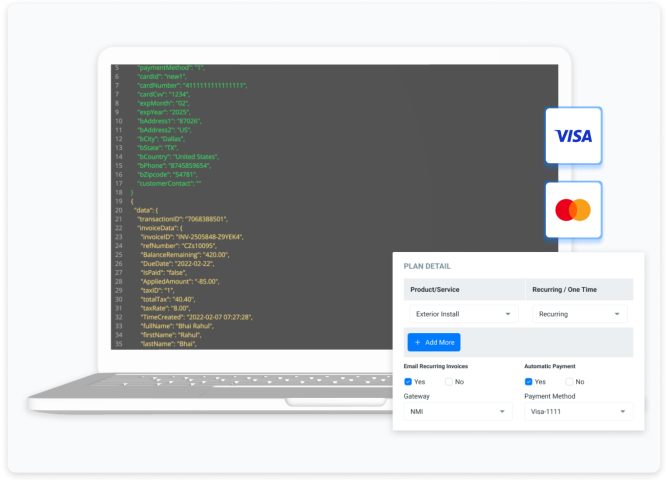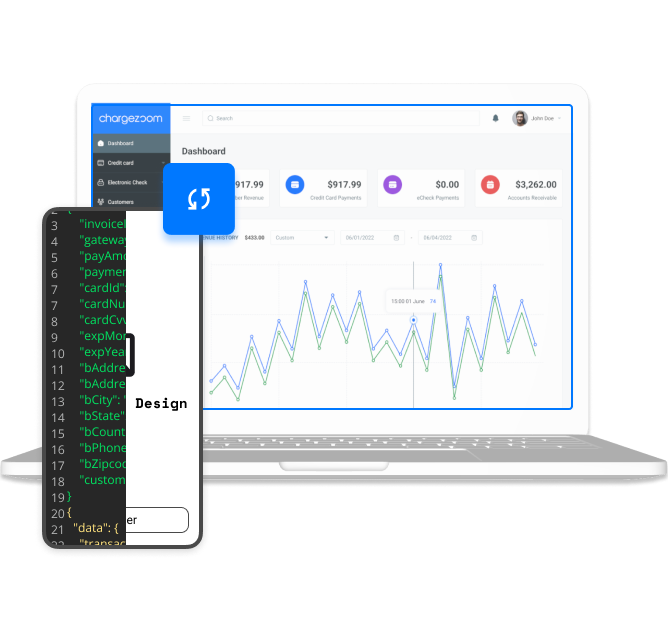
Connect your apps, your way
Integrate payments to your own apps fast without months of costly development. Your developers can easily integrate the Chargezoom API to capture payment details securely while also reconciling data in real-time to your accounting system.
Create elegant solutions for sign-ups, subscriptions, one-time payments, and more. When payments are seamless, customer satisfaction and retention increases.

Save development time and costs
Skip the months or years of custom development and get an immediate boost using the Chargezoom API. Flexible options allow you to build a payment workflow that meets your needs and syncs to all of your systems to boost productivity across all departments.
All data is stored in a secure credit card vault, helping you achieve PCI compliance without additional costs.

Make your developers happy
Chargezoom is a developer-first platform. We make it easy for your developers to get up and running fast. Integrate payments to your applications and payment software in hours, not days or weeks or months.
Need additional help? The Chargezoom development team has a proven history in building customer software solutions for businesses and entrepreneurs.
Whether it’s a custom payment gateway, advanced payment automation, or a specific integration, we will work alongside your team to create the perfect payment solution.
REST API
General and technical questions about our REST API.
What is REST API?
A REST API or RESTful API — is based on representational state transfer (REST) technology, an architectural style and approach to communications often used in web services development.
REST technology is generally preferred to the more robust Simple Object Access Protocol (SOAP) technology because REST leverages less bandwidth, making it more suitable for internet usage. An API for a website is code that allows two software programs to communicate with each another . The API spells out the proper way for a developer to write a program requesting services from an operating system or other application.
The REST used by browsers can be thought of as the language of the internet. With cloud use on the rise, APIs are emerging to expose web services. REST is a logical choice for building APIs that allow users to connect and interact with cloud services. RESTful APIs are used by such sites as Amazon, Google, LinkedIn and Twitter.
How RESTful APIs work
A RESTful API breaks down a transaction to create a series of small modules. Each module addresses a particular underlying part of the transaction. This modularity provides developers with a lot of flexibility, but it can be challenging for developers to design from scratch. Currently, the models provided by Amazon Simple Storage Service, Cloud Data Management Interface and OpenStack Swift are the most popular.
A RESTful API explicitly takes advantage of HTTP methodologies defined by the RFC 2616 protocol. They use GET to retrieve a resource; PUT to change the state of or update a resource, which can be an object, file or block; POST to create that resource ; and DELETE to remove it.
With REST, networked components are a resource you request access to — a black box whose implementation details are unclear. The presumption is that all calls are stateless; nothing can be retained by the RESTful service between executions.
Because the calls are stateless, REST is useful in cloud applications. Stateless components can be freely redeployed if something fails, and they can scale to accommodate load changes. This is because any request can be directed to any instance of a component; there can be nothing saved that has to be remembered by the next transaction. That makes REST preferred for web use, but the RESTful model is also helpful in cloud services because binding to a service through an API is a matter of controlling how the URL is decoded. Cloud computing and microservices are almost certain to make RESTful API design the rule in the future.
Where can I review API documentation?
Our platform was designed as a developer-first product so our documentation is concise and clear for any developer.
View all the details here: https://developer.payportal.com
